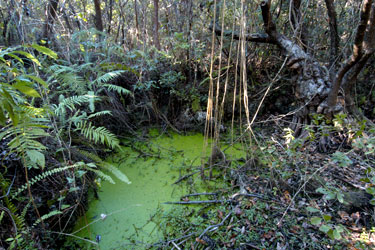Everglades Tours Website
The Everglades are
comprised of more than 100 marsh plant species that live in water during all or most of the year. Its most well-known wetland plant is sawgrass, a thick grass-like
species that has formed thousands of acres of marshes. These sawgrass fields
are also called the Everglades river of grass,
because they grows very dense and cover large areas of land. There are also
many floating plants that inhabit the deeper water of the marshes including bladderwort, and the
white water lily. Periphyton algae also lives among these water based plants. This
algae floats in mats on or just below the water's surface, and is the base of
food webs for most of the aquatic ecosystems in the Everglades.
Everglades Imagery Website
Another
important part of the Everglade's vegetation are the tree islands and the
hardwood hammocks. Tree islands are small woodlands containing relatively short
trees and shrubs that have adapted to the wet landscape. They provide a shelter
and food source to the many mammals that live in the Everglades
and are a breeding ground for many native birds. Tree islands have been given
that name because of the trees that make up the majority of their space, like
the bay, willow and cypress, but they also shelter many other plants such as
orchids, ferns, and bromeliads. The hardwood hammocks are similar in nature to
the tree islands, but are generally located in drier areas, and support trees
which are better suited to that climate, such as oaks, palms, and certain types
of mahogany.
Pinellas County Florida Website
The final type of vegetation that I will talk about is the
mangrove forest. The mangrove is a tropical plant that lives on the coastal
boundaries of the sea. In the Everglades, they
serve as a border between the saltwater from the ocean and the freshwater in
the marshes. The mangroves also help to prevent soil erosion and serve as a
windbreaker, because of their massive root systems and their thickly dispersed
foliage. Key plants such as the mangroves and the trees are vital for both the
plant and animal life in the Everglades.
Resources:
Loveless, Charles. Ecological Society of America:
Ecology Journal "A Study of the Vegetation in the Florida
Everglades" 1986.
Robbins, Erica. Journey to Restore America's Everglades.
"More About the Plants and Animals of the Everglades"
<http://www.evergladesplan.org/facts_info/sywtkma_ani mals>












.jpg)